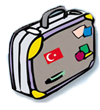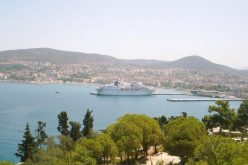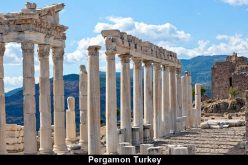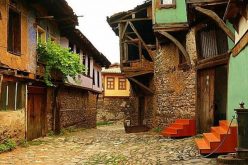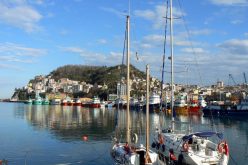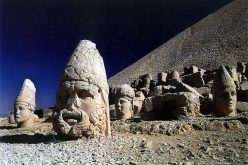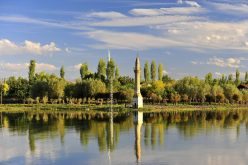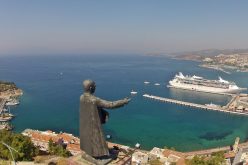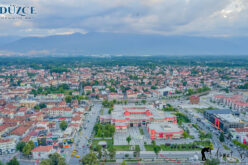Nevsehir
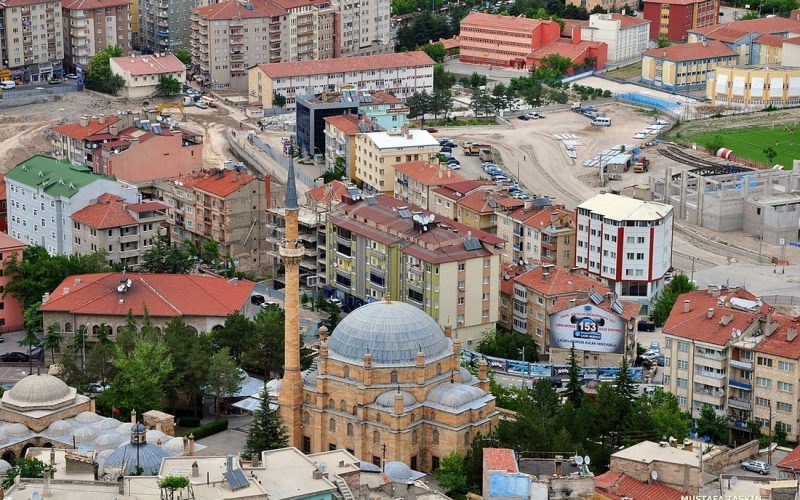
Nevsehir
The province of Nevsehir is one of the major cities of Cappadocia Region in Turkey. And displays a beautiful combination of nature and history. The geographic movements had formed the fairy chimneys and during the historical development process, mankind had settled and inhabited these natural wonders, fairy chimneys and carved houses and churches inside these formations and adorned these settlements with frescos, carrying the traces of the thousands of years of their civilizations.
Nevsehir has a mediterranean climate with cool and snowy winters and warm and dry summers. Rainfall occurs mostly during the spring and autumn. Average rain is 388-353 mm per year and temperature changes between -28°C and +40°C.
Place to Visit ;
The ancient region of Cappadocia is located in central Anatolia between the cities of Nevsehir, Aksaray, Nigde and Kayseri. Millions of years ago violent eruptions of the volcanoes Mt. Erciyes and Mt.Hasan covered the surrounding plateau with tuff. Wind and weather have eroded the soft volcanic rock into hundreds of strangely shaped pillars, cones and “fairy chimneys”, in colors ranging from pink to green and yellow. From the ancient times, men have hallowed out these soft rocks, and they have made countless cave churches, chapels and monastries.
Nevsehir Kurşunlu Mosque (Külliye of Damat Ibrahim Pasha Külliye-Center): The Külliye was constructed by Damat Ibrahim Pasha, who was from Nevsehir in 18th Century. The structure of Külliye is composed of a mosque, a theological school, a library, a youth school, a charitable establishment and a bathhouse. The mosque which is located to the southeast of the Külliye was constructed in the year 1726. The exterior part of the mosque displays a plain appearance while the interior sections are decorated with the embroideries reflecting the characteristics of the Tulip Period of the Ottoman Empire. Hacı Bektaş Veli Dervish
Convent and Mosque (Hacı Bektaş): Hacı Bektaş Veli is a famous Turkish – Islam intellect and thinker who lived in the 13th century. Having a brilliant and superior intellect and personality, Hacı Bektaş Veli had been initially educated in the culture society of the great Turkish intellectual and thinker Hodja Ahmet Yesevi, the patron saint of the Turkish lands and had attained the broad accumulation of knowledge and a wide understanding of the world in Horasan where numerous Turkish scientists had grown up. After he had roamed every city and every village of Central Anatolia, he had founded a Belief and Education Center in Suluca Karahöyük in order to preserve the Turkish traditions and customs and had educated numerous students. Also known as a patron saint in the Janissary society, Hacı Bektaş Veli had assisted to the obtaining of the Turkish-Islam Union in Anatolia.
Dervish Convent and Mosque (Hacı Bektaş): The Kızılca Halvet (suffering house) and its premises was constructed in 14th century by Hacı Bektaş Veli and attachments had been constructed in the following years. The Dervish Convent was restored in 19th century; the structure complex had been overhauled in between 1959 – 1964 by the Charitable Foundations General Directorate and had been arranged as a museum in 1964.
Hacı Bektaş Veli Mausoleum (House of Saint – Hacı Bektaş): The sides of the mausoleum had been composed of side by side three arched eyvan. The entrance to the House of the Saint is from a double door with iron bars under a great archway.
Tokalı (Buckled) Church (Göreme): The church had been located in the Göreme Valley and is the oldest known rock church of the region. The church is made up of four separate sections; single nef Old Church, New Church, the church under the Old Church and the side chapel to the north of the new church. The old church was dated to be constructed to the beginnings of the 10th century. Although the old church is understood as the entrance section of the new church, the structure is original with its single nef, cradle vault structure. The depictions of the Saints, the Joyful Tiding, The Visit, The proof of the Virginity, the voyage to Beytüllahim, the birth, the worship of the three astrologers, the massacre of the innocent children, the escape to Egypt, the presentation of Jesus to the temple, the descent of Jesus to Hell, The ascend of Jesus to the heaven and similar depictions are located in the church. The new church is planned as rectangular in width and has a simple cradle vault structure. Inside its nef of cradle vault, the cycle of Jesus is processed in chronological order with colors of blue and red are frequently used. The Lapis blue is the most important property distinguishing the Tokalı (Buckled) church from other churches. The width wide nef contains depictions displaying the life of Saint Basil, depictions of various saints and mostly the miracles of Jesus. The church is dated to be constructed to the late 10th century and the early 11th century. Monastery of Priests and Nuns (Göreme): The 6 – 7 floored rock mass located to the left of the entrance of the Göreme Open Air Museum is known as “The Monastery of the Nuns“. The dining hall, the kitchen and some of its rooms located at the first floor and the collapsed chapel at the second floor are available for visit. The church located at the third floor (accessible via a tunnel) has a transversal dome, four pillars and three abscissas. The frescos of Jesus which are directly painted on the rocks are adorned with red adornments.
St. Basil Chapel (Göreme): The chapel is located at the entrance of the Göreme Open Air Museum. The church is dated to the 11th century. A portrait of Jesus, depictions of Mother Mary and Child Jesus, depiction of Saint Theodore, depictions of Saint George fighting a dragon while riding a horse could be seen inside the church.
Elmalı Church (Göreme): The church is located inside Göreme Open Air Museum and has a simple plan. Under the preserved frescos, geometric decorations from the icono-classic period had been revealed. According to those decorations, it is understood that the church had been constructed in the 2nd period. The frescos depict the portions of the life of Jesus. The colors used in the church are blue, red and its shades, brown, yellow and white and the details of the clothing in the frescos are stated. The baptism of Jesus, The crucifixion, the alteration, the last supper, the resurrection of Lazarus, the ascend of Jesus to the skies are the major themes depicted at the frescos. The architectural elements such as pillars and pillar titles display the depictions of the saints stated in the bible and some of the prophets. The church attains the name from the apple a garden surrounding the church and the frescos inside the church is dated to the 2nd century.
Yılanlı (Snaked) Church (Göreme): The church is located inside Göreme Open Air Museum. The church contains the depictions of the Saints that are respected in Cappadoccia and is dated to be constructed to the 11th century. Some of the depictions in the frescos are as follows: Jesus holding a bible and accompanied by the Bani of the Church, Saint Onesimus, Saint George and saint Theodore battling the dragon, Saint Oniphrius naked, with long hair and holding a palm tree in front.
Dark Church (Göreme): The church is located inside Göreme Open Air Museum. The church only obtains light from a little window at the narthex and therefore is almost dark. The name of the church is derived from this fact. The structure is entirely adorned with frescos. The church has the most intact frescos of the region. Some of the themes depicted at the frescos are as follows: The protection of the tomb of Jesus by Angels, the crucifixion, the begging of Jesus, the resurrection of Jesus, the last supper of Jesus with 12 apostle, the four saints who wrote the bible together with Jesus, the birth and baptism of Jesus, etc.
Çarıklı Church (Göreme): The church is located inside Göreme Open Air Museum. The name „crackle church“is assumed to be given because of the foot prints that are found under the depiction of the ascension of Jesus to the sky. The church is dated to be constructed at the late 12th century and early 13th century. The Cycles subjecting the life of Jesus, The Pentateuch scene displaying the hospitability of Prophet İbrahim and the depictions of Saint Bani are well preserved. Although looks similar to the Elmalı and Karanlık (Dark) Church, the scenes depicting the walking of Jesus to the Crucifixion and the scene depicting the taking of Jesus from the cross are the different properties of the church. The depictions of the birth, the worship of the three astrologers, the baptism, the resurrection of Lazarus, metamorphism, the voyage to Jerusalem, the treachery, the women following the gray tomb, the ascend of Jesus to the sky and Saints are present in the church.
Saint Barbara Chapel (Göreme): The church is located behind the rock blocks where the Elmalı Church is constructed. Rich geometric patterns, mythological animals and military symbols are painted to the walls and the dome. The walls also contain the depictions of Jesus Pantokreator (Ruler of the World) and Saints Georgia, Theodoros and Barbara. The church is dated to the second half of the 2nd century.
Durmuş Kadir Church (Göreme): The church is in the style of basilica and is composed of a throne of the Priest, large rectangular pillars, place for the baptism event and various shaped tombs engraved in the walls of first section. The church accommodates the most beautiful samples of rock embossed decorations and is dated to be constructed in the 6th and 7th century.
El-Nazar Church (Göreme): The church is located inside the El – Nazar valley, 800 meters away from the road to the right of the Göreme – Museum road. The church is dated to be constructed to the late 10th century. The church contains depictions such as; the joyful tiding, the visit, the birth, the worship of the three astrologers, the escape to Egypt, The presentation of Jesus to the Temple, the persuasion of Elizabeth, the baptism etc.
Saklı (Hidden) Church (Göreme): As the church was discovered in the year 1957, the church was named as the “Hidden Church“. The church is located in the vicinity of El – Nazar Church. The paints adorning the church are directly painted to the main rock body, not on plaster. Painted cloth pieces are found in the surrounding area of the church, and after the executed analysis, it is discovered that the cloths was used as the brush in the painting procedure of the church. The structure of the church is similar to the architecture tradition of the Mesopotamian church architecture. The paintings of the church are as follows; the joyful tiding, the birth, the presentation of Jesus to the temple, the assignment of the Baptist Yahya, metamorphism, etc.
Kılıçlar (Swords) Church (Göreme): The church is located in the Kılıçlar Valley, approximately 600 meters northeast of the Göreme Open Air Museum. The church is richly adorned with frescos and contains a long bible cycles. The church is dated to be constructed to the late 9th century and early 10th century. Inside the church there are depictions such as; the aspect of the prophets, the Joyful Tiding, the Visit, The accusation of Mary by Yusuf, the birth, the dream of Yusuf, the escape to Egypt, the baptism, Jesus and Zakkeus, the cure of the blind man, the washing of feet, the treachery etc.
Meryem Ana (Mother Mary) Church (Kılıçlar Kuşluk Church) (Göreme): The church is located on the steep hill which is located to the south of Kılıçlar (Swords) Church at an approximate distance of 250 meters to the open air museum behind the ridge of Tokalı Church. The church contains the depictions of the saints and the four scenes of the bible cycles. The church also contains the depictions as, deesis, the voyage to Beytüllahim, the birth, the crucifixion of Jesus, the dearth of Mother Mary and the depictions of the saints
Saint Eustathios Church (Göreme): The church is located in between the Tokalı Church and Mother Mary Church. The church contains frescos based on the bible. The church is dated to the early 10th century and there is a carved inscription stating the dates to 1148 – 1149. Tatlarin Church (Acıgöl): The church is located at the side of the hill under which the Tatlarin underground city is located. The scenes at the well – protected frescos are separated from each other with concrete. The color used in the decoration of the ground is dark gray, and the colors used at the frescos are purple, mustard and red. The depictions found in the church are the Mary and the child, the metamorphosis, the descend of Jesus to hell, The entrance to Jerusalem and depictions of nine saints.
Tağar Church (St. Theodora Church-Ürgüp): The church is located in the Yeşilöz village of the Ürgüp district, 16.5 kilometers away from Ürgüp – Kayseri highway. The upper gallery is reached via a stairway and therefore it is the unique sample among the Cappadoccian churches. The frescos of the church are generally well protected and the church is decorated by the styles of three artists. The church was constructed in the name of Saint Theodora and is dated to be constructed between 11th – 13th centuries. There are the aspects of the prophets, aspects of the apostles, Deesis, the Joyful Tiding, the crucifixion of Jesus and the aspects of the saints inside medallions.
Orthodox Church (Derinkuyu): It was built between in 1858-1860. The restoration of the church and its surrounding adjacent to Derinkuyu underground city have still been under construction. Goreme and Urgup districts are two lively tourist centers. There are cave dwellings, as well as the rock cones in and around these cities. Avanos, on the banks of Kizilirmak river and Ortahisar are less visited towns. Superb views of the Cappadocia valley can be seen from the castle located in Uchisar. Goreme Open Air Museum is a complex of churches and chapels, dating back to 10th century. There are great frescoes in many, Yilanli Church, Tokali Church are among the most important. Zelve valley is one the most impressing valleys in the region offering a more disorganised and rough hike. Also there are a number of underground cities used by Christians hiding from enemies. There were rooms for grain storage, sleeping chambers, kitchens and ventilation shafts. Underground cities of Kaymakli and Derinkuyu are the two most important. There are also two others named Mazi and Ozkaynak. Ihlara Valley was created as the basalt and andesite intensive lava from Hasandağı cooled down, and gave way to cracks and subsidence. Streams found their way in these cracks, and the Melendiz Stream, called “Potamus Kapadokus” in antiquity, has eroded the bottom of the valley, bringing it to its present form. The Ihlara Valley is 14 kilometres long and starts from Ihlara and ends in Selime. The valley sides are between 100 and 150 metres high. There are numerous abodes, tombs and churches hewn into the rock face along the valley. The Eğritaş (Inclined Stone) Church, Ağaçaltı (Under Tree) Church, Kokar (Smelly) Church, Yılanlı (Snake) Church, Pürenliseki (Calluna Terrace) Church, Kırkdamaltı Church, Ala (Red) Church, Direkli (Pillar) Church, Fortress Monastery, and Selime Cathedral are among the must-see buildings.
Related Articles
Write a Comment
Only registered users can comment.

